On
Walking Fencing
By
Brian Kirk
ARMA Houston, TX
"but some will say: must one fight mathematically, I say yes,
that to fight with reason is likelier to vanquish the enemy in the approved
truth of the sword than to fight by chance & without reason; for
reason certainly is the best guide in all things"
-William Cavendish, 1650 (punctuation added for clarity)
Starting with the development of Spanish Destreza rapier play in the
late 1500s, there is a strong tradition of Walking Fencing that spread
throughout Europe in the 1600s. From the manuals themselves we find evidence
of this strategy in Italy (Fabris, 1606), the H.R.E. (L'Ange, 1664), France
(Thibault, 1636), the Netherlands (Bruchius, 1671 and Schmidt, 1713),
and England (Cavendish, 1650)*. I am calling this style of fencing Walking
Fencing because even though these manuals differ quite a bit in underlying
rapier theory, they all feature the same walking style of movement. As
I mentioned above, the Spanish called their style Verdadera Destreza (shortened
to Destreza in all future references), the Italian Fabris refers to his
chapters on the subject as "Proceeding with Resolution", while
the German and Dutch masters that he influenced in the later part of the
century refer to the same chapters as Caminiren, (which roughly translates
as "walking" or "proceeding") starting with Huessler
in 1615. Thibault and Cavendish are both of the Destreza influence, although
not the same strain. In this article I will be laying down the principles
of Walking Fencing as I understand them. **
* It should be mentioned here that not all of the above authors dedicate
the entirety of their manuals to this style. In some, L'Ange as an example,
he merely mentions that he is familiar with the style and learned it in
Italy, indicating that Caminiren was at least common enough to be known
by the masters in these nations.
** It should also be mentioned here that the following analysis is
entirely based on the existing literature with respect to the rapier alone,
without a left hand weapon. There are examples of rapier and dagger Caminiren
in Fabris, but in general, it would appear as if Walking Fencing concepts
were not as prevalent within the rapier and dagger community for reasons
that I will address at the end of the article.
The central concept of Walking Fencing is dedicated around the notion
that standing still in a fixed guard is problematic against one who is
in constant motion, not just with the sword, but with the body, and specifically
the feet. This sentiment is almost exactly equal to the idea found in
the oldest longsword treatise (Dobringer Fechtbuk) under the concept of
"frequens motis." In Walking Fencing, this constant motion is
achieved by walking steadily towards your opponent with a walking pace.
The nature of walking means that another feature of Walking Fencing is
a more upright and balanced stance. One cannot walk if one is off balance
or overly contorted in posture, although there are some exceptions, as
you will see.
In contrast, other rapier styles of the time often utilized more right
foot forward, shuffle step footwork, and lunging thrusts at distance.
For this reason, I will refer to this other style of fencing as Lunge
Fencing. Lunge Fencing is what most people think about when they imagine
rapier and smallsword fencing. The Italians even had a phrase describing
this concept as "pie firmo" (firm footed). Walking Fencing and
Lunge Fencing actually often share the exact same blade theory, (ie how
the rapier is supposed to be used against the opponent's blade to achieve
success) but differ in the tempo and body mechanics resulting from the
different footwork and body motions.
Within Walking Fencing there are two central motion theories at play
and two main blade theories. The two motion theories are the Circular
Motion and the Straight Motion. As their names suggest, the Circular Motion
strategy uses angled walking, where you circle your opponent to your right,
or more commonly left, as you approach them. Straight Motion, in contrast,
uses a linear strategy, directly forward to your opponent as you approach
them. Of these two, the Spanish Destreza system utilizes the Circular
Motion extensively, while the Italian Caminiren uses the Straight Motion
more often.
Within both of these motion strategies there are then two blade contact
strategies: Stringeren and Avoidance. The Stringeren theory is that you
should oppose your opponent's blade strongly with your own by gaining
a leverage advantage over his blade as you move toward him. The Avoidance
theory is basically as you come forward, you put your blade into the presence
of the enemy (i.e., the point is on his face or chest) and then move it
by caving (moving your sword down and to the other side of your opponent's
blade) as your opponent reacts to it, thus avoiding blade contact and
putting your adversary into disorder. In this strategy, you are able to
hit your opponent because he is too busy worrying about your point to
notice that you have achieved the "true place" (i.e., the distance
at which you can strike your opponent with a simple arm extension), as
Silver called it.
To show these principles in greater detail, I will begin with Thibault's
manual, which shows in good detail how Circular Stringeren should be performed.
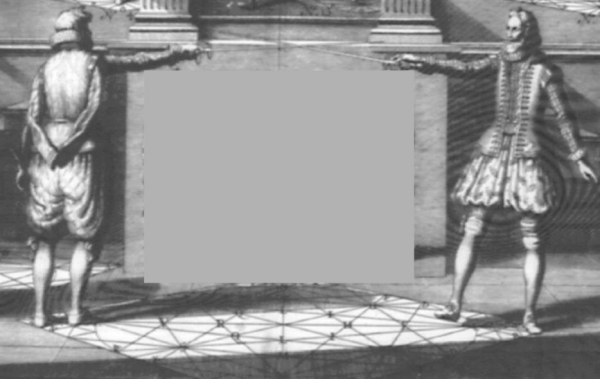
Thibault - example sequence, part 1
Blade is engaged on the inside
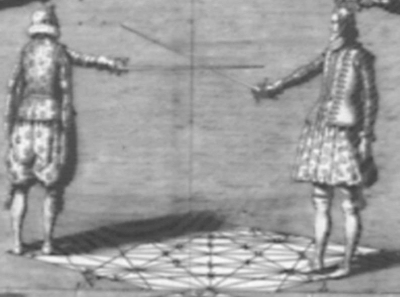
Thibault - example sequence, part 2
Blade is stringered after taking first steps to left
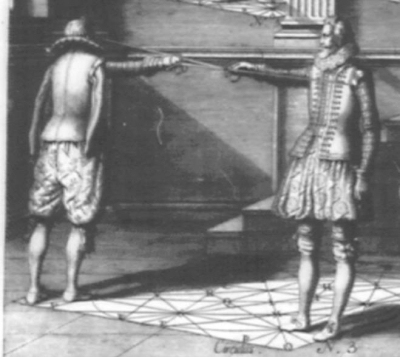
Thibault - example sequence, part 3
Put your blade in the face of the enemy while taking 2nd step to left
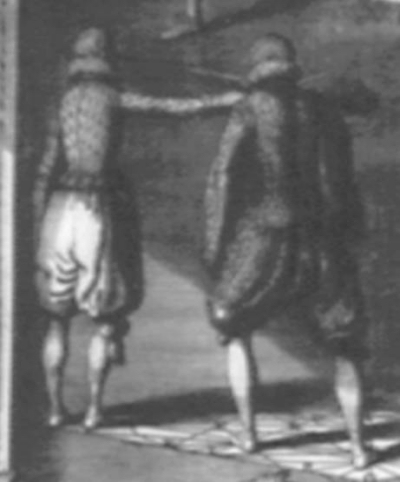
Thibault - example sequence, part 4
If defended, continue to advance the left foot and thrust with a bent
arm to the inside
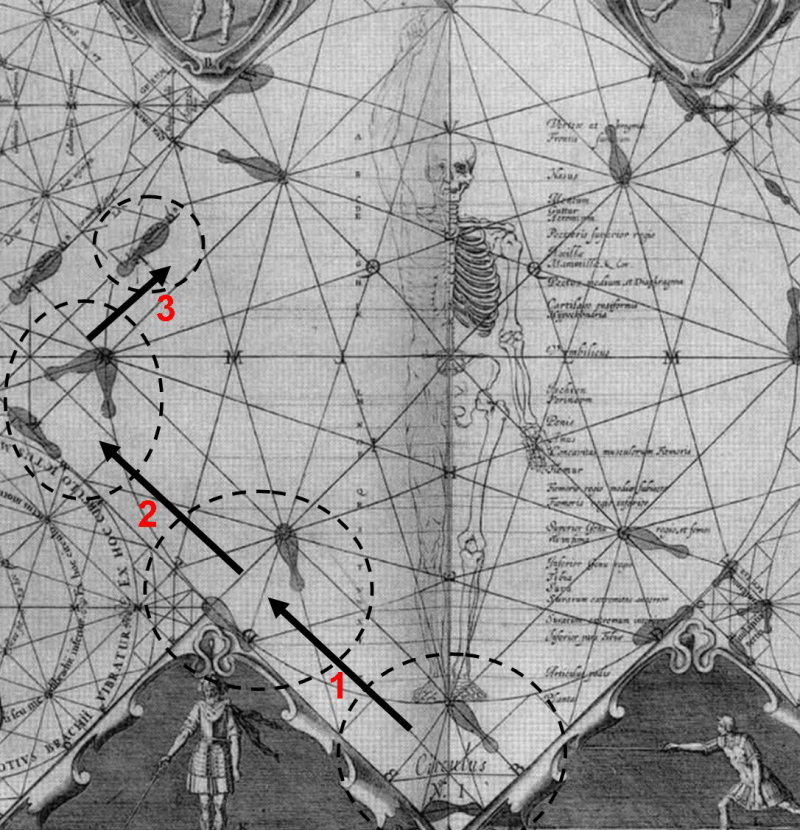
Thibault - Top down view showing the walking motion depicted by the four
images of the example sequence, indicated by the four dashed circles.
The enemy would be standing at the top of the circle, where the skeleton's
hand is.
Steps 1 and 2, depicted by the arrows, involve stepping with both feet,
but the right foot is always in front.
Step 3, however, is done with the left foot only, such that it is now
in front.
(The rest of the imagery in the circle is not related to this discussion;
consult the manual itself for information)
Depicted above, we see how Thibault wants us to walk to our left and
stringere the blade of the adversary as illustrated in part 2 of the sequence.
Once this has been achieved, you can proceed forward diagonally and either
thrust directly (part 3), or if defended strongly, continue on, advancing
the left foot and finishing the thrust with a bent arm on the inside (part
4). This sequence is shown from top down in the circle diagram, so that
you can see the diagonal nature of the attack. It should be noted that
while I consider Thibault to be prescribing a Walking Fencing style, his
footwork actually retains the right foot forward throughout much of his
actions. Therefore, his walking style is more of a shuffling type than
a passing type. This is actually in contrast to least one other depiction
of Destreza, where we can see the passing type of walking depicted, an
example of which is shown below. In this new depiction, step 2 of Thibault's
play is being skipped, so that, as shown below, now point A moves directly
to point B with the right foot, and then to point C with the left.
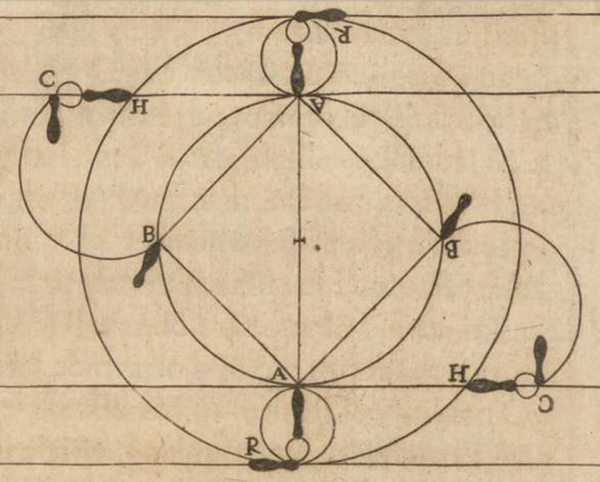
Don Fancisco Antonio de Ettenhard - Taken from his Compendio
de los fundamentos de la verdadera destreza from 1675
The image shows how one might step from location A to location B with
the right foot (going to your left), and then pass your left foot all
of the way to position H, where your right foot can then follow to position
C.
The same basic actions can be made while moving to the right, instead
of the left, as shown, but Thibault spends much less time talking about
it, and I can attest from personal experience that it is more difficult
to make work. The one observation that one should take away from Thibault's
analysis is that when he and other Destreza fencers talk about walking
circularly, we see from the above diagrams that the actual angle of your
approach to your opponent is simply diagonal. If you actually try to walk
circularly, you will find that you are unable to get closer your opponent,
especially if they are moving as well, and you will be unable to make
this system work.
Due to the oddity that Spanish fencing masters wrote many things about
Destreza, but included very few illustrations while doing so, the Thibault
system is by far the most comprehensively illustrated and easily studied
of the Walking Fencing manuals of this era. The next source for us to
consider comes from the Italian Salvatore Fabris. While Thibault and the
other Destreza masters seem to have been only slightly influential to
the rest of Europe, Fabris was quite influential. After his publication
of Lo
Schermo, overo Scienza d'Arme in 1606, a huge number of reprints,
translations, and plagiarisms of his work can be found throughout all
of Europe, and many more works were written by men emulating either the
content or the structure (or both) of Fabris' manual. Fabris structures
his rapier manual into two sections, of which I am going to simplify by
calling the first section Fundamentals, and the second section Caminiren.
The Fundamentals section introduces all of the major elements of rapier
theory which would make him famous, but it is the Caminiren section that
concerns me here. The Caminiren section seems to put forth the idea that
once you are familiar with all of his fundamentals, this is the best mechanism
from which to put them into practice. As such, he introduces 6 rules for
how to proceed against an adversary using Caminiren.
The influence of Fabris being fairly long, I have two separate descriptions
of its use;the first from Fabris himself, and the second over 100 years
later, by the German Schmidt in 1713 (translation by Ranier Van Noort,
link
used throughout). Schmidt seems to have been a student of the Dutch master
Bruchius (see for reference: link),
so while technically Schmidt might be considered to have written a smallsword
manual, he is more directly influenced by the older rapier works than
the French smallsword works (although he references those in his manual
as well). Regardless, he also wrote of the 6 rules of Caminiren, and these
seem to more or less be the same as Fabris'. However, Fabris illustrated
his Caminiren section quite extensively (link),
while Schmidt only scattered a few illustrations throughout, so I will
include some of Fabris' illustrations even though I am using both for
the text. The translation of Fabris that I will be using is the Leoni
translation. For a more thorough description, please consult the originals.
Of Caminiren Schmidt tells us that:
"The Caminiren, or proceeding with Resolution, in thrust-fencing,
is a special way of working, with which you can proceed and hit the
enemy, as soon as you lay your hand on your sword, without placing yourself
in a guard, in whatever guard he may stand, whether he gives a Tempo
or not, whether he parries or thrusts, whether he moves forward or backward.
In short, he can do whatever he likes, but he will be hit infallibly.
This way of fencing then, when executed with all necessary plays, for
which much art, aptness and practice are required, makes the Caminiren
incomparably certain, as awaiting and standing still in guard cannot
do."
Then on walking Schmidt says:
"Concerning the Union and the feet, at the start you must bring
them to a certain speed, just as you tend to go otherwise, but with
a somewhat faster motion, and with smaller steps. You should not extend
or widen these steps, except when the point reaches the enemy´s
body. And you will not make such extension of your steps strongly or
violently. As you must reach with your body to the enemy's body, you
will be unsettled and hindered so much by such violence, that you cannot
lift your back foot with the swiftness that is required, but through
such slowness you will yet fall into complete Disunion."
also that:
"he who has set himself firmly in guard, cannot move a foot
and bring it forth without making two Tempi, namely in lifting and placing.
In contrast, the other, as his feet are already moving, always has one
foot in the air, and without doubt his foot will always be placed before
the other has lifted his. And through this, he has gained an advantage
over the other."
From his introduction, it is clear that both Fabris and Schmidt favor
Caminiren for its ability to put constant pressure to the enemy. It forces
them to either attempt to engage your blade, which is a tempo that can
be used against him, or to thrust from an unsafe position, where the best
he can hope for is a double stab. On this point of blade engagement, it
is very important to keep your tempos small; therefore maintaining your
blade always near the blade of your adversary is very important. Of this
Fabris says:
"If your opponent's sword gets away from you, the tempo will
be lost, and if you were to chase it while going forward you may be
wounded. In this situation, it would be better to quickly retreat and
try to regain the advantage."
Below is a short summary of the concepts at work within Fabris' 6 Rules
of Caminiren (Proceeding with Resolution):
Rule 1 of Fabris and Schmidt's Caminiren is thus to walk directly
at your opponent, to cover their blade with yours in a non-contact stringeren,
on either the inside or outside (inside gets first treatment), and then
avoid their sword through caving until you have gained enough measure
to land either a thrust in opposition, or a yielded Secunda thrust if
your enemy attempts to parry at the last moment. If they retreat, you
follow, continuing to pressure them until they are overwhelmed, shown
below in Conclusion #2. This rule can be best thought of as direct stringeren,
in contrast to the circular stringeren of Thibault. It should be noted
here that Fabris doesn't like blade contact in his stringeren, in contrast
to many other rapier masters. However, in this situation that decision
makes more sense, as having a free blade does allow you to cave and induce
action in your opponent slightly easier.

Fabris - Entering into range
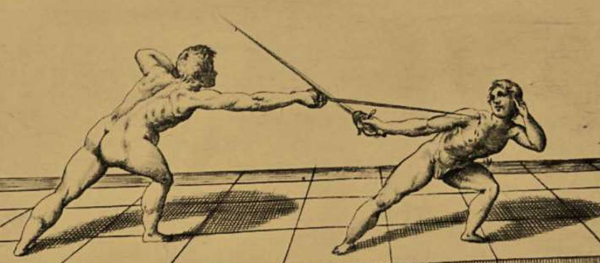
Fabris - rule 1 conclusion 1
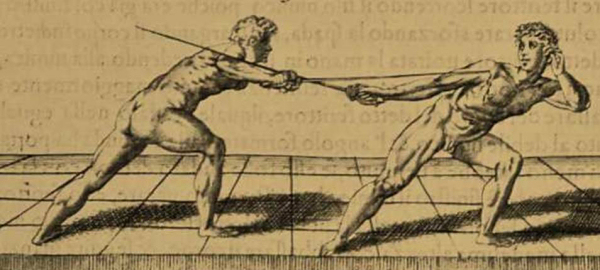
Fabris - rule 1 conclusion 2
From these illustrations we can see that the basic positions are almost
identical to those we would expect to find in the Fundamentals sections.
Here we see a depiction of range being entered into and then either a
Quarta or Secunda thrust on the inside, depending on how strong or weak
our opponent is in their defense.
Rule 2 of Caminiren is to attack your opponent from the outside,
with a broad chest, and to move forward with a high point. Once you are
past the point of your adversary, you engage his sword, still on the outside,
and then bend your body at the waist to bring your head and the point
of the sword towards your opponent, until you land your thrust. As seen
in the first image below, this rule puts you in a little bit of an odd
body configuration, but in principle, the Rule itself encourages a strong
flanking maneuver to the outside of your enemy and so can be thought of
as a circular outer stringeren moving to your left.

Fabris - Gaining the blade on the outside with squared chest
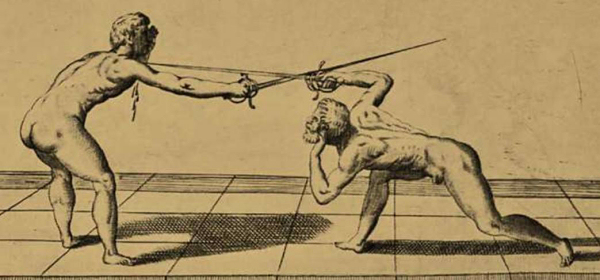
Fabris - Advancing and landing thrust to the outside, with low bent body
Rule 3 of Caminiren is very similar to Rule 1, except that its
goal is to enter deeper into the measure of your opponent to hide your
intention longer. It also presents its first operation from the outside
and the goal here is to land the same set of thrusts as in Rule 1.
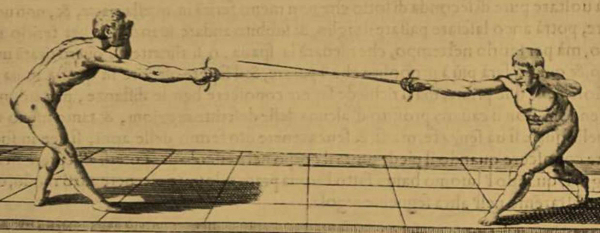
Fabris - Gaining the blade in Tertia from the outside, while advancing
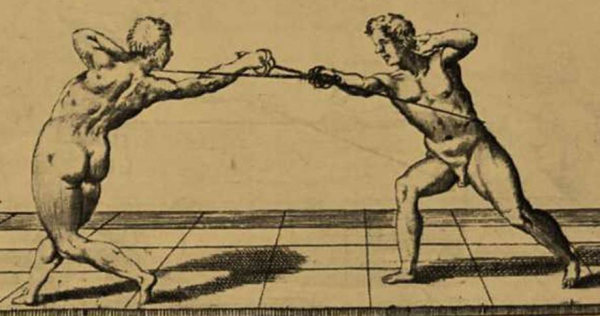
Fabris - Quarta counter-thrust in defense to a quarta thrust volte, by
fighter on the left proceeding from a cave out of the previous illustration.
Rule 4 of Caminiren is to advance straight toward your adversary
and then to take a perpendicular step, either to the right (with the right
foot) or to the left (with the left foot). This brings your body out of
presence with the opponent's point. In the tempo that your opponent tries
to find you again, you stringere and advance again, gaining or caving
according to situation to land your thrust. Consequently, Rule 4 is very
analogous to Destreza, in intent, if not at the exact same angles.
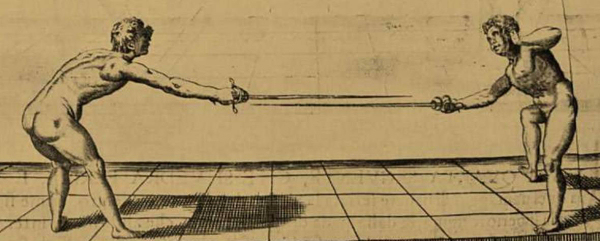
Fabris - Upon entering into measure, the fighter on the right takes a
perpendicular step to the right
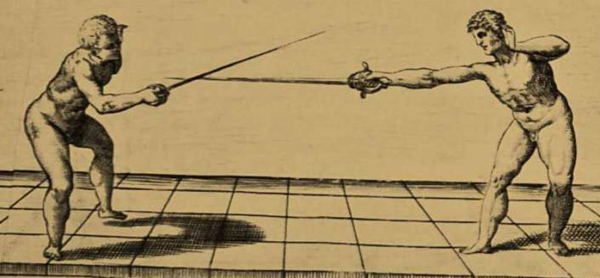
Fabris - The fighter on the left, having stepped to the right, stringeres
his opponent on the inside
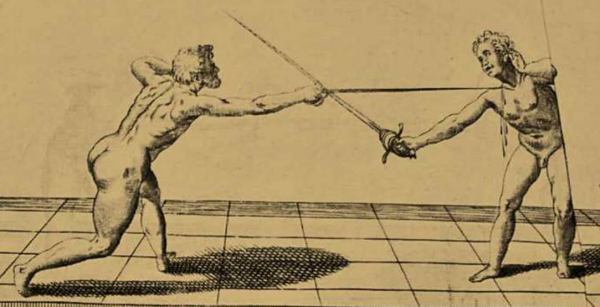
Fabris - Having stringered his opponent on the inside, he passes his left
foot and stabs his opponent in Quarta
Rule 5 of Caminiren is to advance when your enemy has his hand
rather straight, by turning your own point from either above or below,
pointed directly at his hand. In this way, you force him to choose which
side he wants to defend or attack, and you can quickly avoid his blade
in that tempo to strike at his body. You should use your hilt to defend
your body as you turn your hand to make your thrust. Having the point
at your opponent's hand makes caving all the more quick.
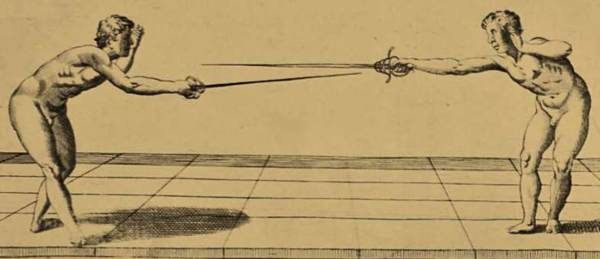
Fabris - Put point at the hand of your opponent from below on the inside
in a low Quarta
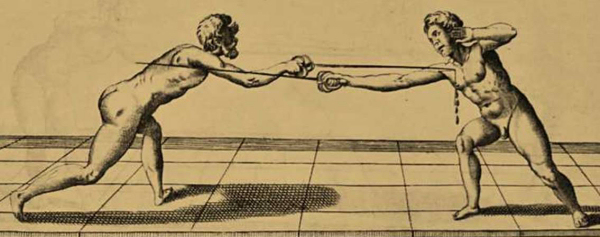
Fabris - Cave and pass suddenly to the outside and thrust over your opponent's
arm
Finally, Rule 6 of Caminiren is to make contact with the sword
of your enemy weak to weak on the blade. You then advance your feet and
body, while maintaining that same blade position, until your body is in
the measure and you can thrust from his blade to his body. The idea behind
this is that your point is never brought into the range in which left
hand action of your enemy may affect it, until you are already set up
to deliver your final thrust.
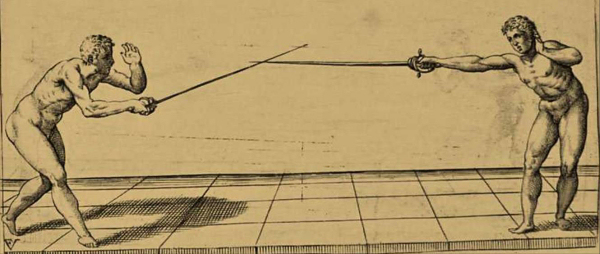
Fabris - Make contact with the weak of the opponent's blade
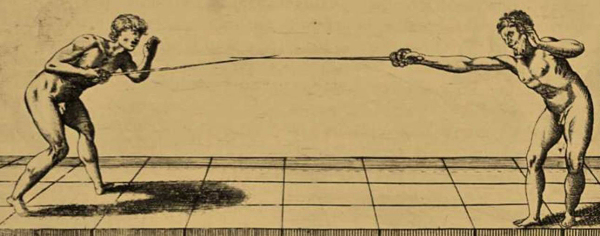
Fabris - Advance without changing position of bind and by withdrawing
your hand
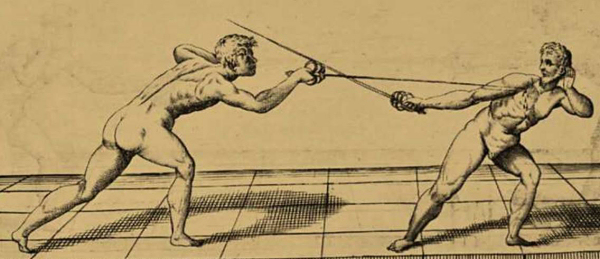
Fabris - Finish with thrust in Quarta
The main thing to keep in mind from these rules is that Caminiren doesn't
ask you to perform anything differently than what was introduced in the
Fundamentals section of Fabris' system. He just asks that you do them
with great fluidity while walking forward.
Similarly, on Caminiren L'Ange says:
"In this, then you do not stand still much, but most of the
time in the action you walk forwards or to the side, and also backwards,
with a straight body, so long and so much until you find an opening
to injure your opponent."
which nicely puts a conclusion on what it is that Caminiren is trying
to achieve. The legacy of Caminiren may ironically be longer in Germany
than in Italy where it was invented. I have found references to Caminiren,
now spelled with a "k" as late as 1798 (link),
in a manual by Johann Adolf Carl Roux.
Finally, in this examination of Walking Fencing we are brought to an
Englishman, Cavendish. He writes his manual seemingly with good admiration
for the Spanish, who he says produced some of the very best blades,
"Of all blades, the old Spanish blades are the best."
and that
"...this play [the Spanish] is absolutely the best play of
all of the false plays."
However, the context of his manual is that he alone is putting forth
the truth of the sword, while all other writers on the subject have produced
false teachings. Cavendish's system shares some of the characteristics
of Destreza, and can be classified as a circular system as such. However,
where Thibault would have you circle to the left so that you might stringere
your opponent's blade on the inside, Cavendish would have you circle to
the left while putting one's blade to the outside instead. In this way,
one moves in a circular manner only to flank the enemy in that direction.
His system of Walking Fencing thus asks that
"your oblique walking still is to get behind him, which he
will never suffer there, for half will serve to wound him & be sufficient
for you," (punctuation added for clarity)
In this, he means that as you get a better angle on him, it forces your
opponent to turn, and this turn represents a tempo that can be attacked.
If your opponent doesn't turn, then you gain strength over his outside
by bringing in the left shoulder and putting both the force of your arm
and your body against just the force of his arm alone. This gives you
the strength to enter your thrust from the outside. If your opponent does
turn, but too much, then you cave to the other side and advance your right
shoulder find your opponent's blade. Thus your opponent finds himself
suddenly with his left shoulder too far forward, and you have his whole
chest to thrust to. In this way, it seems to share quite a bit with Fabris'
Rule 2 of Caminiren, which also strives to attack the outside with squared
shoulders.
Following these descriptions of what Walking Fencing is, the next question
that must be asked of these systems is whether or not they remain martially
effective in a self defense environment, or instead, they are only suitable
for duels among noblemen who are also versed in these systems. To begin
to test this, let us break down Walking Fencing and access what its strengths
and weaknesses might be. Some of these observations come from the masters
themselves, others by logical inference, and some from my practical attempt
to make this work in sparring.
Walking Fencing is very good while moving forward. There is a certain
aspect of Terminator-like determination to using steady forward pressure
on your adversary. Unfortunately, this can also be somewhat of a disadvantage
against someone who just wants to back up against your advance. If your
opponent moves backwards at the same speed as you move forward, then nothing
is accomplished. Therefore, it may be necessary to appear just out of
range as being willing to fight stationary at the onset, just to get your
opponent into the mindset to dig in and fight you.
Additionally, Walking Fencing does not operate very well while you are
going backwards, or once stopped. It is notable that within the entirety
of Thibault's manual, there are zero examples of how to deal with an opponent
capable of driving you backwards. Within Caminiren, there is a little
more discussion on what happens when you have been thwarted in your initial
approach. There, one is told that they can withdraw, change tactics and
then start pressing forward again. Another weakness that can be exploited
is when you have stopped. Basically, if you are stationary, then you are
now equal to the Lunge fencer that you are fighting, except that they
are probably more set up for their lunge than you for your defense. Additionally,
your first walking step after stopping will always be slower than an opponent's
lunge, so if you have stopped within range (which is the only place you
could be forced to stop anyway), you are susceptible to all of your opponent's
quick actions. For this reason, it is probably better to spring backward
in defense rather than to stop completely; and if you are forced to stop,
then it is absolutely critical that you keep your point in the presence
of the enemy's chest or face.
It also should be at least mentioned that you have to be very conscious
of how your blade is positioned and moving against someone who either
has a dagger, or is simply prone to using off hand parries extensively,
when you are trying to keep your point in presence. Point presence is
nice, in theory, because it forces your opponent to deal with that point
before they can think about acting against you. However, using either
the left hand by itself, or a dagger, your opponent can attack your sword
right at the onset (or at wide distance) and this can be very problematic
to you. If your blade is so stationary that it can be grabbed, or otherwise
engaged, it prevents you from proceeding with any of your Walking Fencing
strategies. Hopefully though, if they have a dagger, then so do you, and
you probably won't be using Destreza-style Walking Fencing to begin with,
as dagger use is not a hallmark of that training. I will say that a Cavendish-like
approach is potentially quite appropriate however, as it actively works
to take the left hand of your opponent out of the equation all together,
by constantly probing your opponent's outside lines.
Continuing on, the speed at which you advance is very important to a
proper balance of intent in Walking Fencing. If you advance too fast,
you risk missing an observation that your opponent is working against
you, which if they can get their point in your presence, might force you
to stop, further diminishing your advantage, or have you simply run into
their point. Advancing too slowly just allows your opponent's natural
quickness to eventually find a spot to land home a thrust. The most difficult
aspect of actually using Walking Fencing is that you potentially have
to operate your hands and your feet at different speeds, independent of
one another. While your feet maintain a pace appropriate to managing the
distance from which your opponent is working, you have to alternatively
have at some times very still hands, and at other times very quick hands,
but whichever the case, it can't affect your feet. Doing so only puts
your body into disorder or forces you to stop. Yet you may also, at times,
need to act very quickly with the feet, once you have achieved the measure,
in order to make sure that your point finds its mark before your opponent
can retreat.
Lastly, a related issue is that your opponents tend to also move while
you are fencing them, even if they are just doing Lunge Fencing themselves.
This is particularly problematic to any of the circular methods, as all
of those diagonal approaches can be thwarted if your opponent moves in
a counter diagonal to maintain the distance. In these situations, it may
be necessary to switch from a Circular type Walking Fencing into a Linear
type Walking Fencing in order to change the dynamic of the fight. The
key to Walking Fencing is thus patience and thoughtfulness. It is important
to not be forced to move faster than you want to and to maintain a cool
head. I think that the best aspect of Walking Fencing is that it promotes
calmness in your fighting and a good tactical awareness for what your
objectives are in your fencing at any given moment.
In conclusion, the reality is that even Lunge fencers tend not to stay
in one place forever, and any pursuit that one makes to a retreating adversary
will have certain aspects of Walking Fencing built into it. Additionally,
almost all passing steps promote Walking Fencing-like behavior, as they
are usually followed up with a right foot advance, and two consecutive
passing steps in a rapier fight might be the entirety of the fight. Therefore,
the question that arises is: is that Walking Fencing, or is it just Lunge
fencing done quickly? The reality is that they are probably both. In fighting,
it is far too easy to be forced to stop to be only a Walking Fencer, but
we are constantly told by multiple masters, over hundreds of years, that
movement and angles are critical to obtaining success while fencing. Therefore,
one is also correct in criticizing someone who remains too stationary,
or locked into their guard. I believe that the trend we see again and
again is that Walking Fencing is not "special." Instead, it
is just good technical fencing done while constantly moving your feet.
It is not more or less complicated than any other form of fencing, provided
that you don't actively put your feet in a position to get in your own
way, and all that it takes not to do that is to move at a reasonable pace
while advancing. Still, Walking Fencing is not shuffle/sprint foil fencing
either, or perhaps more common amongst currently practicing rapierists,
constantly circling but just out of distance; and so it does still need
to be learned and practiced as its own thing.
My hope with this article is not to prove that Walking Fencing is superior
to Lunge Fencing, only to demonstrate that it was much more prevalent
historically than the popular representations of the past (within the
fencing community, not just popular culture) would have you believe, and
to further highlight that there are many different ways to use a rapier.
And with that, some final advice from Fabris:
"If you wish to proceed against the opponent, you should start
by moving your feet at an ordinary step, as if you were walking - only
quicker and with smaller strides. The step should not be widened until
the point of your sword reaches the opponent."
"It can also happen that the opponent performs a cavazione
in order to find your point on the other side, leaving his body in the
same place or withdrawing it to find your sword before your forte starts
penetrating his guard. In this case, you should perform a contracavazione
before your opponent touches your blade; every cavazione executed after
the opponent touches your blade is dangerous and is not performed in
the correct tempo."
"This last technique works because the one who walks forward
is always quicker than the one who goes backward. If you stop every
time your opponent withdraws and makes a mutation, he can keep frustrating
your designs by doing so every time he wants. This is why you should
never stop as long as you proceed correctly. But should you lose your
advantage, then it would be wise to stop and recover until you can regain
it."
|

